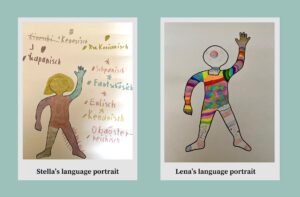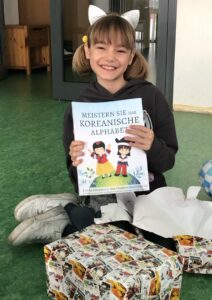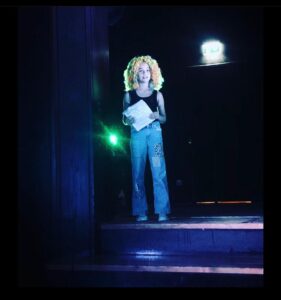In the setting of a cozy living room in Vienna, two young minds, Lena (10) and Stella (8), equipped with colored pencils, embarked on a creative journey that would unveil the anatomy of their linguistic repertoires (quite literally). As they filled in silhouettes of themselves on a DIN-A3 sheet of paper with vibrant colors, little did I expect how extensively their drawings would serve as windows into their worlds where language intersects with personal experiences, emotions, family dynamics and aspirations for the future.

Context and methodology[1]
Lena and Stella are siblings from Vienna, whom I have known for most of their lives as I had the pleasure of watching them grow, learn how to express themselves and explore their interests since their early years through regularly looking after them. They are members of Generation alpha, the youngest cohort alive, born between 2010 and 2025. This generation is unique as they are the first to grow up with digital technology as an integral part of their daily life from birth onwards (Eldridge, 2024).
At the time of this project, Stella was in primary school while Lena attended secondary school. The siblings’ first language is German. At school, both children have made their first regular encounters with formal English language education. As I wanted to investigate whether their linguistic repertoire[2] would extend beyond these two languages, I chose the biographically oriented method of language portraits (cf. Busch, 2018, p. 3), which allows for a multimodal representation of the participants’ linguistic repertoires and lived experiences. Language portraits not only function as a practical tool for research to examine multilinguals’ heteroglossic[3] repertoires but can also be useful for reflective purposes (Busch, 2018) and for fostering language awareness (Krumm & Jenkins, 2001).
Therefore, on a rainy Wednesday afternoon in April, I asked the girls to fill in an empty body silhouette by placing specific languages and varieties, which are present in their lives, into parts of their bodies. I told them that they do not have to be proficient in these languages and that they could use colors, symbols, language, drawings, and more to indicate language(s) and anything they associate with them. Visual methods also have the potential to produce narrative data (Busch, 2012, p. 511) and to unveil an individual’s associations, emotions, ideologies and biographical experiences related to language (Melo-Pfeifer & Kalaja, 2019, p. 279; Krumm & Jenkins, 2001). Consequently, after the sisters were done with their portraits, I conducted short follow-up interviews, asking the siblings to elaborate on their silhouettes. I subsequently analyzed the interview transcripts in MAXQDA2022 by employing qualitative content analysis according to Kuckartz and Rädiker (2019).
Findings
Lena and Stella’s artworks illustrate how globalization, family dynamics, and educational environments shape the linguistic repertoires of these young language learners and users. The results of the analysis revealed that the five pre-defined themes from the interviews (linguistic repertoire, experiences and associations, emotions, language placement, color choice) consisted of a range of different subtopics mentioned in relation to the language portraits, which will be presented below.
Linguistic repertoire
Lena and Stella were not raised bilingually, but even a quick look at their language portraits reveals that German is not the only linguistic resource, the sisters draw upon. In total, the sisters reported seven languages and two dialects. While Stella drew six languages and two dialects, Lena chose to include four languages relevant to her. Lena also dedicated considerable body space to future languages she is to encounter in her life . Interestingly, Stella forgot to indicate German explicitly on her language portrait (“Stella: Mein Gott, ich hab Deutsch vergessen (kichert)“). However, she did discuss two distinct Austrian dialects, namely, Carinthian and Upper Austrian, which, judging from the following statement, were considered as separate languages that must be acquired before they are intelligible (“Kärtnerisch, weil wir jedes Jahr eine Woche auf den Berg gehen und da hören wirs echt oft. Und ich verstehs mittlerweile auch schon”).
Color choice and language placement
With regard to the color choice, Stella announced that she would not pick colors intentionally before the interview. Lena, however, carefully drew three national flags (Korean, French and Austrian) into her silhouette and used the colors of the Union Jack to indicate the English language. Concerning language placement in the silhouettes, some choices were made unintentionally (Stella: “[…] meine Haare, weil ich einfach keinen Platz mehr hatte für Kärntnerisch“), while other languages were deliberately put into specific body parts. It is noteworthy that although the children drew their language portraits in separate parts of the room, they both chose to put Korean into the heads of their silhouettes. As reason for this, Stella mentioned her special interest in Korean TV shows (Stella: „Koreanisch weil in meinem Kopf, weil mich interessiert Korea sehr, weil wir […] haben sehr viel koreanische Liebesserien geguckt“). Lena gave a similar explanation: “Also ich habe auch Koreanisch in meinen [Kopf] gegeben, […] weil wenn wir das schauen muss man halt denken, weil wir schauen das meistens mit Untertitel, weil wir das nicht können.“ As Stella and Lena cannot speak Korean, they usually watch their favorite Korean TV with subtitles. Therefore, Lena put Korean into her head because reading the subtitles and watching the show requires sharp focus.
Lena used her silhouette’s legs to emphasize the importance and frequency of language use: German because it is her first language („weil wir reden ja Deutsch und so“) and English because she attends English classes at school („Dann habe ich Englisch in den Beinen, weil ich habe ja auch sehr viel Englisch, also ich habe vier Stunden in der Woche Englisch. Immer. […] meine Beine brauche ich die ganze Zeit und Englisch eigentlich auch“). French is crayoned further up because she has not started to learn French yet, as the following quote illustrates: „dann habe ich Frankreich hier [Bein], weil in der dritten Klasse muss man sich dann entscheiden, ob man den sprachlichen Zweig nimmt oder den naturwissenschaftlichen und dann werde ich den sprachlichen nehmen und da hat man auch schon ab der dritten Klasse Französisch.“ Therefore, while French does not have an important place in her life at the moment, it will play an essential role once her French classes start. This quote also nicely indicates the strong link between Lena’s linguistic repertoire and her biographies.
Experiences, associations and emotions
The languages included in the silhouettes were mentioned in connection to prominent interests, experiences, and emotions. As already touched upon above, the languages were often related to institutional exposure (Stella: “Englisch, weil wir es in der Schule seehr oft machen. Jeden Freitag haben wir eine Stunde“.) and skill (Stella: „[…] deswegen habe ich Chinesisch genommen und weil ich auch drei Wörter auf Chinesisch kann“). Furthermore, associations of languages and their varieties with their family and holiday activities were also indicated by Stella: „Oberösterreichisch, weil wir sehr oft nach Oberösterreich fahren zu meiner Oma, weil sie sehr oft etwas mit uns unternimmt. Sie geht mit uns reiten und macht sehr viele Sachen mit uns.“ Stella associates the Upper Austrian dialect with family trips to her grandma’s and fun family activities.
Further prominent associations to languages constituted, as already mentioned above, TV shows. Stella even mentioned three different TV shows she connected with the languages she chose for her portrait (Chinese, Korean and Spanish), for example: “Stella: Chinesisch [Bein], weil meine absolute Lieblingsliebesserie aus China kommt.“ In addition to the TV shows, Stella also talked about items displayed in the shows, and therefore, linked to the respective language and show: “[…] dann hatten die so coole Sachen und dann hat meine Mama mir immer solche Pokemon und es gibt ja solche Hauben und wenn man so Luft rein, dann kommen solche Ohren.“ In the same breath, Stella mentions her interest in Korea, Korean, Korean TV shows and Pokemon as well as other kinds of merchandise from these shows. For this project, the respective subtopic was, therefore, called commodified languages. For Stella, instances of commodified languages often co-occurred with intense emotions: Stella: “Das sind auch südkoreanische Sachen, die lieb ich jetzt irgendwie soo gern!“ While Lena did not specifically address her emotions and rather stuck to the facts, Stella even visually indicated her positive emotions in the language portraits (“Stella [while drawing]: Ich mache Herzchen zu den Sprachen, die ich liebe und Sternchen zu den anderen.“) and was happy to talk about her love for Korean, Chinese, Japanese and French.
Stella: Family and the media
Audiovisual media play an essential role in Stella’s life as they serve to open doors to unknown languages and cultures. This is also emphasized by Stella’s affinity for products featured in these TV shows. Lanza (2021, p. 764), who researches multilingualism in families, concludes that globalization is a prominent factor, which intensifies “the encounters of different traditions, values and languages of the various members of the family.” Although the family, to which Stella and Lena refer to as “we”, speak German to communicate with each other, Stella mentioned her family members in connection to different languages or varieties of German in six different instances, which also reflects the significance of her family in her life. Families usually form their own community of practice, i.e., they have their own ways of communicating, believing, and acting (Lanza, 2021, p. 767). Embedded in and together with her family, eight-year-old Stella explores her interests in various languages. This is also nicely portrayed by the fact that two out of three words she knows in Chinese refer to mother and father.

Lena: School and what is yet to come
Although there are overlaps between discourses by Stella and Lena, most of Lena’s statements refer to languages in the institutional context of her school. Concerning the shared association of Korean with their favorite TV show, it was noteworthy that both children chose the head of their silhouette, a very prominent body part, which once again highlighted the family as a community of practice. Studies employing language portraits with groups of children have observed similar connections between nation and language (Soares et al., 2021, p. 30-32) and nation and media, such as film or music (Muller, 2022, p. 3651). It was striking that in addition to Korean, German, and unspecified future languages, Lena focused on English and French, which she both linked to her current English classes and her future French classes. Muller (2022, p. 3656) reported that in her study, some pupils deliberately chose to exclude languages “imposed by the educational language regime”. This was not the case for Lena, who, instead, aimed her attention at (future) languages she encounters in school.

Of course, the two language portraits are not generalizable to Stella’s and Lena’s whole age cohort. Rather, they depict these two siblings’ individual linguistic repertoire and associations, experiences and emotions with language. By employing language portraits, an in-depth perspective of Lena’s and Stella’s language- and lifeworlds could be obtained, which is not only relevant to multilingualism researchers but also to parents and other caretakers. Despite speaking German at home and being taught English at school, the sisters’ linguistic repertoire goes beyond these two languages. In fact, these two members of the youngest generation in our society today are surrounded by a variety of different languages. Languages and interest thereof are not only formally acquired in institutions but also picked up extramurally at home through the media – for example by indulging in Korean TV shows – or through family members – in this case, in the form of dialects acquired from grandparents.
Lisza-Sophie Neumeier is an MA student of English Language and Linguistics and has finished her MEd (Teacher Education Program for English and History) in October 2023 at the University of Vienna. She has been working as student assistant and communications officer for the research platform #YouthMediaLife since October 2020 and as a history STEOP tutor from 2018 to 2022. Her MEd thesis was a mainly quantitative study concerned with informal second language learning and foreign language enjoyment in recreational, professional and educational spheres among young adults in Austria. Her latest publication on the genre of academic conference tweets displays her research interest in social media discourse and genre analysis (OA).
[1] This small-scale study was conducted in the context of an Advanced Course in Applied Linguistics on “English in 21st-century lifeworlds”, held by Prof. Ute Smit at the University of Vienna.
[2] According to Busch (2012: 521), the linguistic repertoire contains “all the accepted ways of formulating messages, thus enabling a move away from thinking languages and codes as bounded entities.” Languages, varieties, codes and potential other means of expression are equally included in this definition.
[3] Busch (2018, p. 8) defines heteroglossia (Greek: hetero = “different”; glossia = “tongue, language”) according to Bachtin (1979, qtd. in Busch 2018, p. 8) as a “complex plurality of languages, voices and discourses.”
List of references
Bachtin, M. (1979). Die Ästhetik des Wortes [Toward the aesthetics of the word] (R. Grübel, Ed.). Suhrkamp.
Busch, B. (2012). The Linguistic Repertoire Revisited. Applied Linguistics, 33(5), 503–523. https://doi.org/10.1093/applin/ams056
Busch, B. (2018). The language portrait in multilingualism research: Theoretical and methodological considerations. Working Papers in Urban Language & Literacies, 236.
Eldridge, S. (2024). .Generation alpha. In Encyclopedia Britannica. https://www.britannica.com/topic/Generation-Alpha
Krumm, H.-J., & Jenkins, E.-M. (Eds.). (2001). Kinder und ihre Sprachen: Lebendige Mehrsprachigkeit; Sprachenporträts [Children and their languages: Thriving multilingualism; language portraits]. Eviva.
Kuckartz, U., & Rädiker, S. (2019). Analyzing qualitative data with MAXQDA: text, audio, and video. Springer Nature Switzerland.
Lanza, E. (2021). The family as a space: Multilingual repertoires, language practices and lived experiences. Journal of Multilingual and Multicultural Development, 42(8), 763–771. https://doi.org/10.1080/01434632.2021.1979015
Melo-Pfeifer, S., & Kalaja, P. (2019). 15. Conclusion: Lessons Learnt With and Through Visual Narratives of Multilingualism as Lived, and a Research Agenda. In P. Kalaja & S. Melo-Pfeifer (Eds.), Visualising Multilingual Lives (pp. 275–284). Multilingual Matters. https://doi.org/10.21832/9781788922616-019
Muller, S. (2022). Visual silence in the language portrait: Analysing young people’s representations of their linguistic repertoires. International Journal of Bilingual Education and Bilingualism, 25(10), 3644–3658. https://doi.org/10.1080/13670050.2022.2072170
Soares, C. T., Duarte, J., & Günther-van der Meij, M. (2021). ‘ <i>Red is the colour of the heart’</i>: Making young children’s multilingualism visible through language portraits. Language and Education, 35(1), 22–41. https://doi.org/10.1080/09500782.2020.1833911
